
 by Jonathan Stroud
by Jonathan Stroud
JournalistsForSpace.com
Journalists For Space sat down with NASA astronaut Tom Jones for an exclusive one-on-one interview at the San Diego Air and Space Museum to discuss his career, his thoughts about Mars, his views on commercial spaceflight, and his newest book Ask the Astronaut.
Jones has flown on four shuttle missions, STS-59, STS-68, STS-80, and STS-98 spending a total of 52 days (1,272 hours) in low Earth orbit as an astronaut. During his last mission, he performed three Extravehicular Activities (EVA) to assist with the assembly of the American Destiny Laboratory on the International Space Station (ISS). Prior to NASA, Jones served six years on active duty in the Air Force where he accumulated over 2,000 hours of jet experience.
He earned a Bachelor of Science in Basic Sciences from the United States Air Force Academy and a Doctorate in Planetary Science from the University of Arizona where he researched remote sensing of asteroids, meteorite spectroscopy, and applications of space resources.
Jones has authored books such as: Sky Walking An Astronaut’s Memoir, Planetology, Hell Hawks!, Ask the Astronaut and others.
Inspired as a child by the book Space Flight and other science fiction, such as 2001: A Space Odyssey, Jones dedicated his life to achieving his dream of becoming an astronaut. He now travels the country giving public lectures to share his experiences and to help inspire future generations of astronauts.
Check out the official Ask the Astronaut Facebook page by Clicking Here.
“Be persistent; be stubborn; be determined. That’s one of the ultimate things I learned from all of my astronaut colleagues.”
– Tom Jones
Interview with an Astronaut
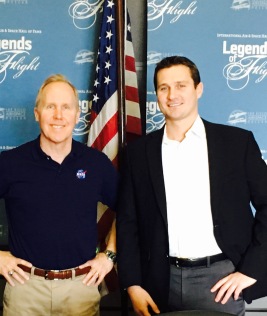
Q: How did your perspective on the planet and humanity change as a result of your shuttle missions?
Well, there’s the human reaction to seeing the Earth from space, and it’s a lovely planet when you see it from a couple of hundred miles up. You’re moved by the beauty of the planet. It’s always changing. It’s always different. Weather conditions are changing every orbit; every time you look out the window, there’s something new with different lighting conditions. As a human who likes beauty, you appreciate it; it’s a lovely place.
I can imagine, in the future, that somebody will be going to Mars and they won’t be able to enjoy that view and they’ll be crestfallen. Not being able to see the Earth will leave an empty space in their heart.
Aside from that, I’m a planetary scientist; so, when I look down, I see geological forces at work: wind, water, and ice erosion. I see tectonics and volcanoes. I’m very interested in the clinical description of a planet at work.
Then, there’s all the geography and all the history of human society written on the face of the planet. When I look down and see places where momentous things have happened around the world, I go, “That’s where that was; it’s just like the map of my geography book,” or, “It’s not like the map in my geography book. It looks different.”
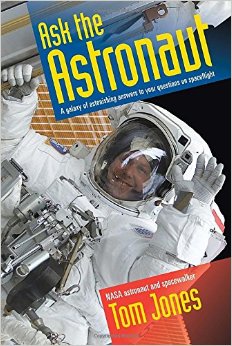
Q:What inspired you to write your latest book Ask the Astronaut?
Well, I have done a lot of public speaking for NASA and even before NASA I was doing Space Sciences and always doing Q&A’s; so, I’ve been asked thousands of questions over the years. I began to realize that I was seeing a lot of the same questions and there was a bell curve of rare but interesting questions that not many people asked.
You can help a live audience out by answering questions, but it made me realize that there are thousands of people around the world who never get a chance to talk to an astronaut or to see one speak; I certainly was in that boat when I was growing up. I didn’t meet my first astronaut until I was in college. If they lack that opportunity, then they don’t get a chance to ask some of these popular questions; so I started cataloguing the questions I was getting and keeping an informal list.
I thought that it would be good to write a book that I could keep updated within the next couple of decades. That way, we can all stay up-to-date with developments in the space program and in space exploration around the world.
Q: What was the hardest question to answer in Ask the Astronaut?
Personal questions are the hardest to answer: “Were you scared? Did you think you were going to die? Have astronauts died in space?” You get those in regular talks.
How do you explain how you can climb into a rocket and risk your life? It’s especially hard when your wife is sitting in the audience, but you have to tell her the answer; so you might as well share it with the public too.
Another question I always get is: “How do you balance the costs and risks of space exploration with the benefits that we get from it?” That’s a thoughtful question and I have to answer it too. I can’t just say, “Well, it’s obvious.” It might be obvious to me because I get to ride the rocket, but it’s not so obvious if you’re a taxpayer. I really have to respond with some good rationale for that.
Q: Do you have any plans for future books?
Oh, yes. As soon as I can get back to my office I want to start the proposal for An Astronaut’s History of Human Spaceflight. It will be very broad, in terms of writing, but the book will be about Alan Shepard, Yuri Gagarin, all the way up to the present.
A lot of people in my audience were born after Apollo; they have no firsthand recollection of how we got to the moon. It’s just a page or two in a history book to them. I want to retell that story in an interesting way, and of course, there are plenty of great ways to illustrate a book like that. I certainly would like to have that book out in time for the Apollo 11 anniversary.
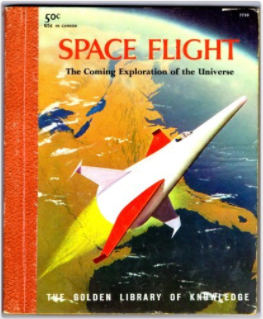
Q: What inspired you in the book Space Flight as a child that made you want to become an astronaut?
Well, the astronauts in Space Flight were illustrated–there were no photos since it hadn’t happened yet. It was about what could happen in space exploration in the coming decade. The moon was just one of several places in that book where humans or robots could go, but that’s what appealed to me. It was based on a very broad, far-reaching, and imaginative idea. It was based on the Collier’s series of the 1950’s about where humans could go in space. It was a sort of von Braun and Chesley Bonestell vision of space exploration.
The book [Space Flight] had this far-ranging imagination that appealed to me and once I had that book on my shelf, I started reading other books. It was right at the beginning of the space race. John Glenn had his first flight a couple of years later.
When NASA moved into the Gemini program, I was living two miles away from the Titan factory in Baltimore where the Gemini boosters were being built. That was a big impact on me because my schoolmates’ parents were working at the factory making the rockets.
I went down to the factory as a Cub Scout and saw them building the rockets carrying the Gemini astronauts. I remember seeing Gemini 7 and Gemini 8 being assembled and tested in the vertical there.
It was happening right where I lived; the space race came right into my hometown. That really grabbed me and inspired me.
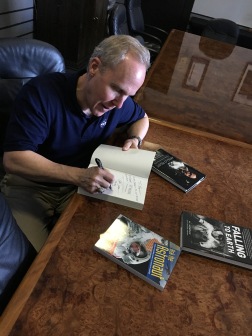
Q: What is the single proudest moment of your career?
I just take a lot of satisfaction in being a team member on all of those flights. I flew with 20 different astronauts and I like to think that they look back at the time we worked together with some satisfaction, just as I do. We all helped each other out and we got big things done.
Meeting guys on the space station wasn’t about who did what and it wasn’t about one person getting the job done. It was about the crew getting something done together. We all took a lot of satisfaction in helping each other out, and at the end of the day, we accomplished something together as a group. I never anticipated that.
When you become an astronaut candidate, you work with veteran astronauts who have been up in space before while you’re waiting for your first mission. They don’t tell you about one of the neat things about spaceflight: doing things together and coming back as a member of a team who has successfully accomplished something. I think, overall, my greatest satisfaction was just being a contributing member of those teams, including the mission control guys and the people who I worked with in space.
As a personal highlight, it would have to be the spacewalks that I did. Those were certainly essential to the mission that we did on the space station. It was a real privilege to be picked to get to do a spacewalk and to go outside and plug the U.S. laboratory into the space station.
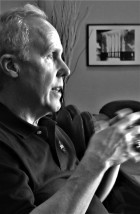
Q: Did you come across any situations that were unanticipated during any of your missions?
We had a mission on Columbia where we were going to do a couple of spacewalks. Tammy Jernigan and I were scheduled to go outside, but the hatch jammed and we couldn’t go out.
They canceled the spacewalks on that mission because of the mechanical failure. That’s something we never trained for. They never said, “Oh, by the way, the door knob might not open and you might not be able to go outside.” That was a completely unforeseeable scenario, and yet it happened.
What you learn from that is that you should expect the unexpected while up in space. You will always be surprised by something. If you’re lucky, you have run through the scenario in your mind beforehand or practiced it on the simulator. If you’re not lucky, then you’re going to have to wing it or wing it with the help of mission control.
We tried to deal with that problem and there was just no way to solve it mechanically while we were in space; we had to call off the spacewalk. That was unexpected and a huge disappointment for us up there.
Tammy and I got the opportunity to do spacewalks later on, and again, it was thanks to the people we worked with. Our boss met us on the ground after we landed and he said, “I know how disappointed you are. I will try to get you an assignment that gets you on a spacewalk as soon as I can.”
Another surprise in my career that was a heart-sinking development was when we were at the space station. We had trained to hook up all these utility lines to the outside of the laboratory, but we sprang an ammonia leak on one of the cooling hoses. That wasn’t something that we had practiced very much on the ground.
It was a coolant line which can leak, but we didn’t really get into detailed scenarios of how to deal with that. We did talk to the engineers in the weeks before the mission where they said, “OK, if you have a problem with this coolant line, if it’s not flexible enough, if it won’t bend right, or if you can’t make the connection work properly…let’s talk about some workarounds for that.”
Since we had discussed this generally, we knew enough about the configuration of the valves in the cooling system to deal with the sudden leak.
My partner Bob Curbeam was the one who really had to respond quickly and in a very timely way to stop the leak from occurring. Once Bob stopped the leak, which was a big achievement by Bob, he and I got together for the problem on the space station.
After working for over half an hour, thanks to Bob’s quick work, we got the lines plugged back in and bypassed the leak. Then, we restored the coolant flow and had only lost about five percent of it.
During the moment that it was leaking and shooting ammonia crystals across the vacuum of space, we were looking at the comet tail of vapor and snowflakes and going, “Oh my God, they don’t simulate that on the ground.” It’s a matter of trying to do what you can and remembering what you have rehearsed. You have to keep your cool, which Bob certainly did, and then work together to solve the problem.
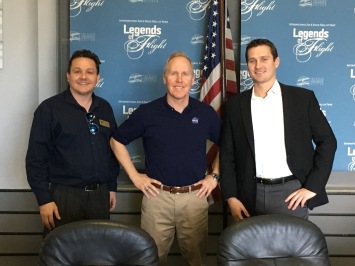
Q: During your time in the astronaut corps, was there a lot of strain on your marriage and family?
Unquestionably.
Yeah, we looked at the history of my astronaut class which I think had 23 people. Half of them were divorced either by the time we got into the astronaut corps or during the course of it–mostly during the course.
It’s tough on relationships and I certainly knew the stress my family was under; my wife had the brunt of that. I didn’t really understand that until I got the job of becoming an astronaut escort for another crew who was flying.
I was on the roof of the launch control center at launch time with the spouses of that astronaut crew. Knowing I was going to get to fly in space someday and I was thinking, “This is great.”
There’s a shuttle launch: “Ten, nine, eight, seven…” and I look at their faces and know that if this launch is successful, they’re going to have a vacation in a couple of weeks with their spouse. If it’s not, their lives are completely changed. That’s sobering. You can see that on their faces.
By the time my wife was up there, I’d already done that escort job; so, I helped advise our crew on who we should pick to be the escort because you want somebody who can be there for them if you don’t come back. You must make that very sobering decision about who is going to be there with them. As my wife puts it, the escort is the one who would be escorting the wives into widowhood.
So, you’re aware of that, but it’s when you put your family through six countdowns…I did four flights and four launches. There must come a time when you have to stop putting them through that wringer. Yeah, the work was very important and great benefits came from it, but there’s the personal commitment that you make and it is not just yours. You’re committing your whole family; at some point, you have to give them some relief. After my four flights, it was time to shift gears and try something else.
The people who go up on the space station and spend six months or more up there…that’s a real serious commitment. You’re like a military family; they are deployed for six months, but they’re in space.

Q: How do you feel about private companies such as SpaceX and Boeing being tasked with taking future astronauts to the ISS?
It’s a really integrated part of our national space effort. Those folks are providing logistical support to the space station at a lower cost than NASA could do it. They could restore our domestic capability to get to orbit in a couple of years.
It will be seven years of dependence on the Russians by the time we get our feet back under us again. That’s embarrassing. However, in the future, it will be a very good thing to turn the routine and semi-routine flights to low Earth orbit over to private commerce where they get to do a repetitive job. They can keep improving it and keep dropping the cost while NASA can keep doing the pioneering work out on the deep space frontier and focus on really cutting-edge exploration.
It’s good that NASA is getting out of this so-called trucking business and getting into exploration again.
I hope we’ll have the resources to do that job justice out there on the moon, on the asteroids, and on Mars so that we’ll never look back. We will never look into the future and see a time when the commercial firms are not involved in a big part of the national space effort. They may be shipping cargo to the moon or landing commercial payloads on the moon’s surface. When we go to an asteroid, the cargo module is going to be a commercially delivered contract item that somebody will deliver at a lower price than a NASA prime contractor could.
Q: What are your thoughts on NASA’s current plans to send humans to Mars?
Well, Mars is a great horizon goal and the ultimate goal for NASA, but I don’t think we are ready to go there now.
We’re not going to be ready in five years; we may not be ready for 25 years. There’s still a lot of homework to do, but in the meantime, we should be working on something closer to get us practical experience so that when we go to Mars, it’s not a huge leap into darkness. It’s got to be the short, logical next step and something similar to what we have already done.
We should return to the moon and use those same spaceships to go to a nearby asteroid over the next 10-15 years. Then, when we’re ready to go to Mars, we’ll have already built a habitat on the moon, had spaceships go for a six-month journey to an asteroid and back in deep space while exposed to radiation, created reliable life support with a new generation of spacesuits–we could then build on that to go to Mars. All those things will come along with working on the moon and on an asteroid so that when we get to Mars, it’s not everything new all at once. It will be just one little step farther than what we have been doing.
That’s the only way we’re going to reliably succeed. At this point in time, I think NASA needs to focus on a course correction. Use the machines that we’re already building to do things closer to us.
When we’re ready with international partnerships, we can get to Mars in 2040 or something like that. That’s where I come down on it. I think that, ultimately, we will go to Mars, but that shouldn’t be the driver. The driver should be getting some near-term experience and economic benefit from working around the moon and the asteroids.
That’s where everybody else is going to be: the Europeans, the Russians, the Chinese. If we’re saying, “Yeah, you guys are on the moon right now, but we’re going to go to Mars in 15 years.” That doesn’t really cut the mustard. You know you’re not going to be a leader with an argument like that. You actually have to be doing things in space at the cutting edge.

Q: Do you have any advice for aspiring astronauts or younger generations?
Yeah, that’s why a third of this book [Ask the Astronaut] is devoted to future careers in space. I talk about my background and experiences [in the book], but ultimately, the end of the book is about exploring the solar system, cosmology, astrophysics, big bangs, black holes. “Your Future In Space” is the final chapter; that’s why I wanted to write this book. I wanted to give a 10 year old or a 15 year old some practical advice on how to get into the space program.
My advice would be: don’t give up. Be persistent; be stubborn; be determined. That’s one of the ultimate things I learned from all of my astronaut colleagues. Almost everybody I got hired with had tried multiple times to get into NASA’s astronaut corps.
Another hopeful message I would give them is that NASA needs devoted and dedicated people. They’re looking for people who won’t give up and are persistent. There is a need for those types of people. Three thousand people applied the year I applied and I was still successfully hired. Last time NASA called for astronaut volunteers, there were 18,000 applicants. NASA is very competitive. The good news is that not only are they hiring, but SpaceX, Bigelow, Boeing, and other aerospace companies are hiring. Jeff Bezos with Blue Origin will be hiring people to work in space or work on the ground in support of the space missions. The space sector is a lot broader and a lot deeper. Nowadays, people have broader opportunities than I did. It’s going to be a very, very exciting two decades ahead of us where the 10 year olds of today will be the people on the cutting edge of exploration in the next 20 years.
Jones concluded the interview by asking the Journalists For Space audience to, “Give the book [Ask the Astronaut] a read. Let me know at my Facebook page for Ask the Astronaut or send me an email with questions that I didn’t answer so I can improve the book the next time we revise it. Then, if they really want to dive into something more deeply personal, then they should read Sky Walking about my four flights and the way a human responds spiritually and technically to that experience, I think they would enjoy that too.”
Buy Ask an Astronaut by Clicking Here.
Check out his other books and more Tom Jones content on his website by Clicking Here.
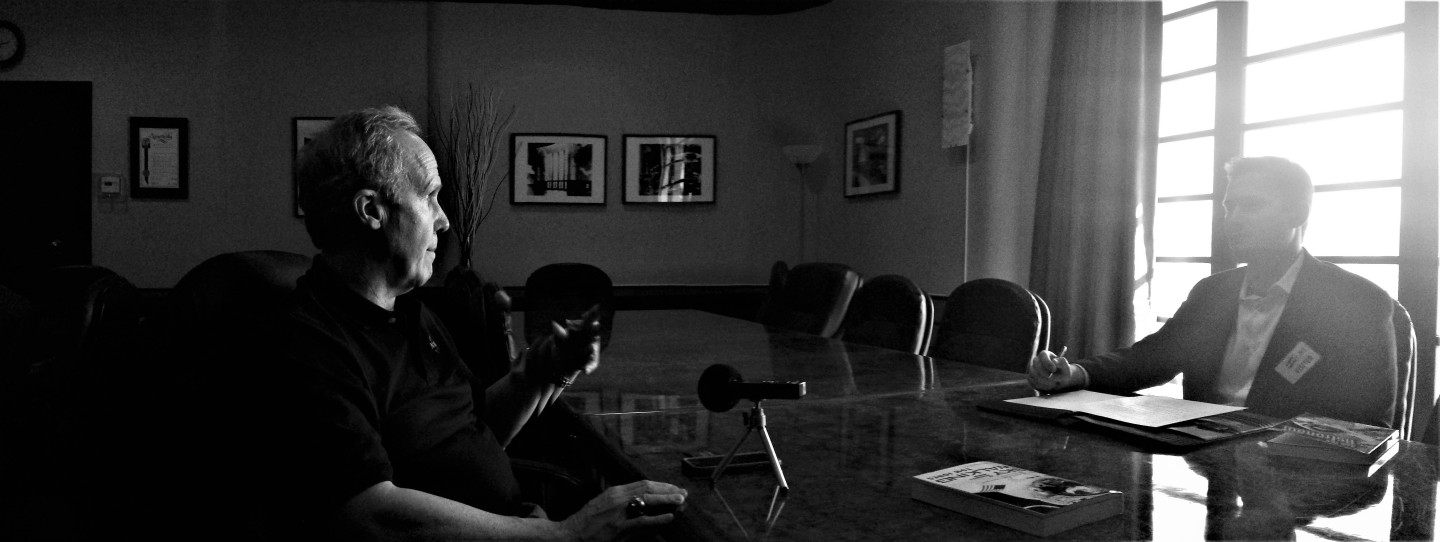

Leave a comment